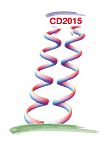Speaker
Frederic Brünner
(Vienna University of Technology)
Description
I present new results on glueball decay rates in the Sakai-Sugimoto model, a holographic top-down approach for QCD with chiral quarks based on a probe-brane construction within Witten’s holographic model of nonsupersymmetric Yang-Mills theory. We calculated [1] rates for decays into two pions, two vector mesons and four pions, using a range of the ’t Hooft coupling which closely reproduces the decay rate of ρ and ω mesons and leads to a value for the gluon condensate consistent with QCD sum rules. We concluded that the holographic mode corresponding to the lowest excitation of a dilatonic scalar provides a narrow glueball state in the right mass range for an identification with f0(1500) or f0(1710), while the results actually favour the latter as a glueball candidate. This conclusion receives further support from our latest work [2] on implementing finite masses for pseudoscalar mesons by extrapolating from the calculable vertex of glueball fields and the η meson, which is a consequence of the Witten-Veneziano mechanism. In line with the mechanism of chiral suppression [3], we found a considerable enhancement of the decay of scalar glueballs into kaons and the η meson, in close agreement with experimental data on f0(1710).
References
1. F. Bruenner, D. Parganlija and A. Rebhan, Glueball Decay Rates in the Witten-Sakai-Sugimoto Model, arXiv:1501.07906.
2. F. Bruenner and A. Rebhan, Nonchiral enhancement of scalar glueball decay in the Witten-Sakai-Sugimoto model , arXiv:1504.05815.
3. M. Chanowitz, Phys. Rev. Lett. 95, 172001 (2005).
Primary author
Frederic Brünner
(Vienna University of Technology)
Co-authors
Anton Rebhan
(Institute for Theoretical Physics, Vienna University of Technology)
Denis Parganlija
(Institute for Theoretical Physics, Vienna University of Technology)

